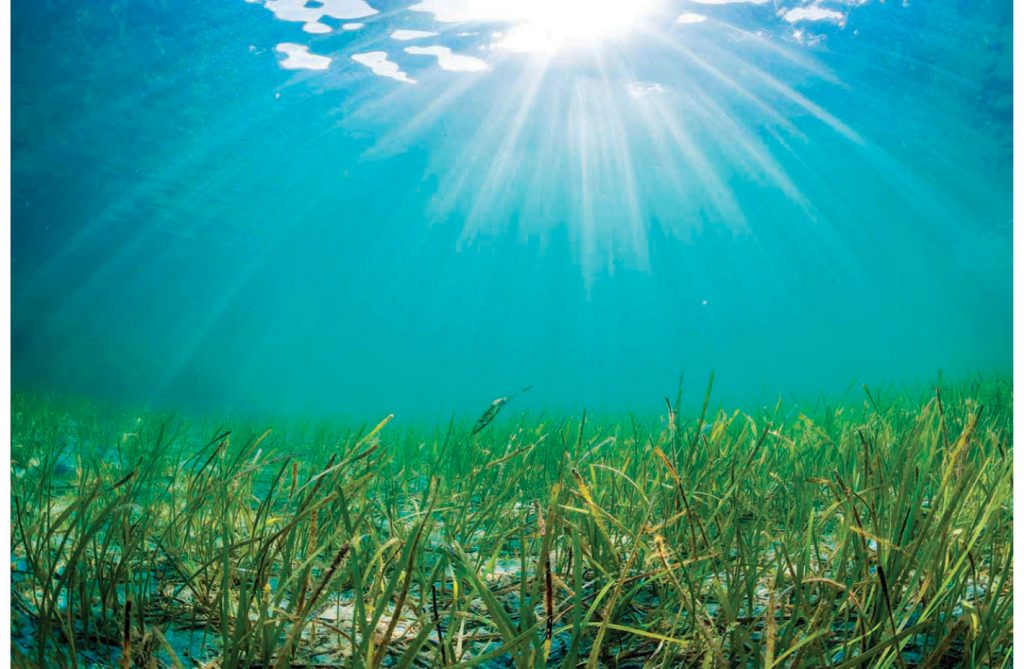By Shelley Brown, Director of Sailors for the Sea Powered by Oceana

Seagrass meadows are a vital part of the marine ecosystem, but careless boat operators are inflicting significant damage. © UVA
Beneath your hull is an underwater world full of beautiful, crucial ecosystems, including seagrass meadows. Generally growing in shallow coastal waterways, seagrasses are found across the globe from the tropics to the Arctic.
Healthy seagrass beds have a wide range of positive impacts for our waterways. The dense underwater meadows provide spawning and nursery habitats, areas of refuge, and feeding grounds for many fish and invertebrates. Marine animals, including green sea turtles and manatees, rely on seagrass for food and sustenance.
Seagrasses enhance water quality by absorbing excess nutrients and filtering water of pollutants and sediments. Many seagrass species produce an extensive network of roots and rhizomes that stabilize sediments to help protect the shoreline from erosion. These underwater plants also help mitigate climate change by capturing and storing significant amounts of carbon dioxide from the atmosphere.
Seagrass meadows are among the most productive ecosystems in the world, however, boating can have a devastating impact on these sensitive habitats if boaters don’t take the proper precautions while navigating shallow waters.
What is prop scarring?
Seagrass scarring is caused by boats entering shallow waters where propellers, motors and hulls come into contact with seagrass beds. As the propeller slashes into the seafloor or the hull and motor drag across the bottom, it creates physical damage to the crucial root systems of the seagrass and leaves a visible scar.
Over time, erosion and scouring from waves and currents in damaged areas can result in scars expanding, causing additional loss of seagrass. In south Florida alone, more than 30,000 acres of seagrass have been damaged by boat-generated scarring. Recovery and growth of the seagrasses in scarred areas can take years, and if damage continues to occur, may never be able to recover. Prop scarring is a significant, but also preventable threat to crucial seagrass bed habitats.
What can boaters do to protect seagrass beds?
• Use navigational tools: Review charts, fishing maps, or local boating guides to become familiar with your local waterways and learn where shallow waters are located. Operate your boat in marked channels or deeper water while under power.
• Read the water: While on the water, wear polarized sunglasses to reduce the surface glare, which will help you see seagrass beds. Whenever possible, avoid those shallow areas.
• Know your depth and draft: If boating over seagrass in shallow water, be sure to trim your motor up and idle to a safe depth before getting on plane. Keep the times for low and high tides handy.
• Stop the engine: If aground, do not proceed under power. Turn off and trim up your motor. Pole or push your boat to a safe depth.
Taking these simple steps while boating can help preserve the health of our seagrass beds and local waterways. ■
Shelley M. Brown Ph.D. is a native Rhode Islander who has spent a lifetime sailing with family from Bar Harbor, ME to Long Island, NY. She has a doctoral degree from the University of Rhode Island with a focus on microbial ecology in coastal marine environments. She is the former program director of the Block Island Maritime Institute (BIMI), was a member of the education team on the Hudson River Sloop Clearwater, and has served as a visiting scientist at the Environmental Protection Agency (EPA), Atlantic Ecology Division.
This Ocean Watch Essay was originally posted on the Sailors for the Sea Powered by Oceana blog, and is reprinted with permission. To learn more about how you can join the race to protect the world’s oceans, including becoming a Green Boater, log onto sailorsforthesea.org.




